News Around NIDDK
Patients drive kidney disease research forward with precision
By Steven Winter
National Kidney Month is recognized each March to raise awareness of kidney disease and actions people can take to keep their kidneys as healthy as possible. It’s also a time to reflect on the 37 million people in the United States and multitudes more worldwide affected by kidney disease. While they, and the millions of others affected by the conditions and diseases in NIDDK’s mission, are at the heart of the research that NIDDK conducts and supports, patients themselves have been getting more deeply involved in research and making valuable contributions.
 Dr. Sanjay Jain, KPMP
Dr. Sanjay Jain, KPMP
Recent NIDDK-supported research in kidney disease exemplifies the enormous impact that patient engagement can have on advancing research. Through the Kidney Precision Medicine Project (KPMP), researchers created the most comprehensive “human kidney cell atlas” to date. The atlas allows scientists to compare healthy and diseased kidney tissue at the cellular and molecular level, marking an important breakthrough toward understanding and treating kidney disease through precision medicine, a key part of NIDDK strategic research goals.
The creation of this groundbreaking atlas was made possible through the generosity of study participants who voluntarily donated their kidney tissue samples. Obtaining these samples can be invasive and does not provide immediate health benefits. However, a KPMP priority is in ensuring patient safety, by maintaining practices that guarantee sample collection meets the highest safety and ethical standards. The deep commitment of patients to advancing research is matched by the scientists involved. “The impact of these selfless acts on tomorrow’s discoveries is enormous,” said Dr. Sanjay Jain, KPMP investigator and one of the builders of the atlas. “The best way we can repay their altruism is by generating knowledge and mechanistic insights for discovering new kidney disease treatments.”
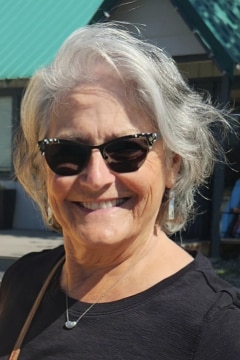 Christy Stutzke, KPMP Patient Partner
Christy Stutzke, KPMP Patient Partner
From the start, KPMP project designers committed to engaging patients at every step and including them as equals with the investigators throughout the program’s planning and research. The “patient partners” contributed significant insights and perspectives and were listed as co-authors on KPMP manuscripts.
“Though we may not have the levels of medical education the researchers may have, we do have feelings as patients about how we are treated, and we have voices that need to be heard,” said patient partner Christy Stutzke.
Stutzke keenly appreciates that KPMP researchers took so much time to explain medical terminology to her and other patient partners, which greatly expanded her understanding of kidney disease since she joined the investigative team. This patient-involved approach creates a dynamic that is helpful for all.
 Emanuel Holley, KPMP Patient Partner
Emanuel Holley, KPMP Patient Partner
A KPMP research participant, Emanuel Holley, came to the study with reservations. When he was 34 years old, and a few years after being diagnosed with diabetes, Holley was told he had kidney disease. In past encounters with the health care system, he often felt ignored and not recognized by health care providers. He says his KPMP experience was different. He appreciated the support he received from his study coordinator throughout the project and says they have stayed in communication.
“I felt both seen and heard,” Holley said. When asked why he donated his tissue, he added, “I did it for tomorrow’s people. I don’t want the next Emanuel to get kidney disease.”
Stutzke also expressed how happy she was to pay it forward. “I am so proud of the fact that my experience with kidney disease could someday help people across the globe,” she said.
In January, the KPMP published about a second kidney atlas focused on chromatin, a mix of DNA and histone proteins in eukaryotic cells that form chromosomes and regulate gene expression. The absence of diagnostic references such as these atlases have long hampered the development of new drugs and treatments. One reason that a baseline reference tool like the kidney atlas has not existed previously is because kidney biopsies were generally not collected in response to kidney disease since the same few treatments were the only options available for patients with kidney disease.
“The KPMP participants are the true heroes of biomedical research and deserve huge thanks from us all. Their contributions are truly inspiring,” said NIDDK Director Dr. Griffin P. Rodgers. “Because of their commitment, we continue progressing towards finding better, more precise ways to prevent and treat kidney disease.”
NIDDK publishes 2024 annual scientific report
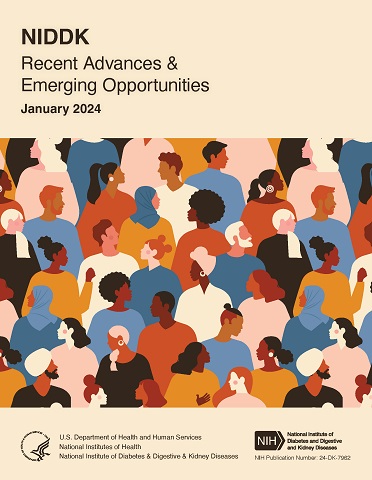
The NIDDK annual report for 2024, NIDDK Recent Advances and Emerging Opportunities, is now available. The report highlights examples of NIDDK-funded research advances from fiscal year 2023. Special features include topics such as liver disease research advances, development of alternatives to race-based kidney function calculations, and milestone anniversaries of the Diabetes Research Centers and the Special Diabetes Program.
The report also contains “Personal Perspectives” from people who have participated in or supported NIDDK-sponsored clinical research.
NIDDK’s Office of Scientific Program and Policy Analysis leads the production of this report with input from the Institute’s extramural divisions and offices and the Division of Intramural Research.
New edition of “Diabetes in America” now available
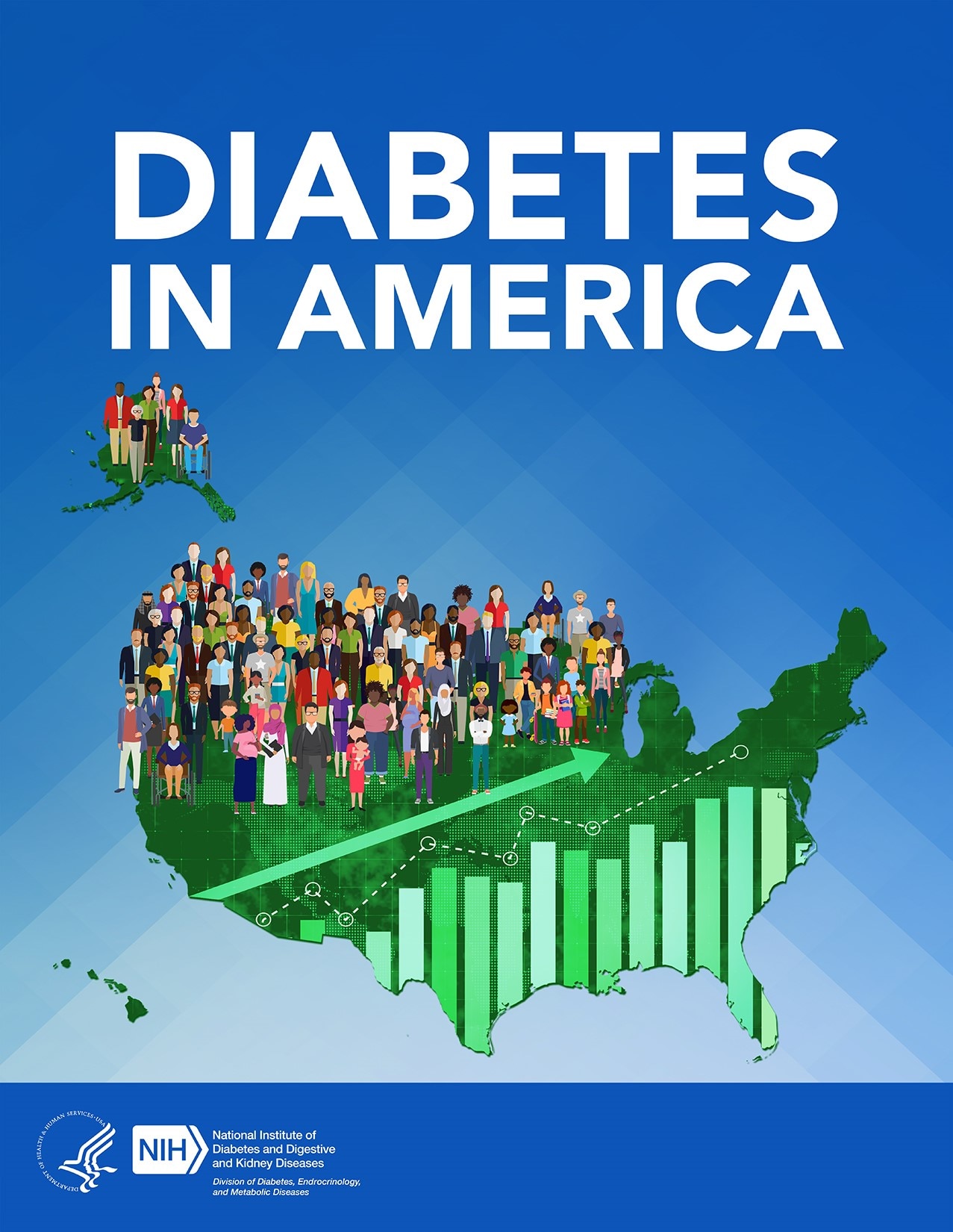
NIDDK’s assessment of epidemiologic, public health, clinical, and clinical trial data on diabetes and its complications in the United States, “Diabetes in America” covers the spectrum of diabetes, describing data and trends, complications of diabetes and related conditions, prevention, and medical care.
With contributions from leading diabetes experts from around the world, “Diabetes in America” is a comprehensive resource for the research community, clinicians, policy makers, and people with diabetes, as well as their caregivers and family members. In addition to updates on topics covered in previous editions, the new edition includes brand new topic areas such as obesity management for type 2 diabetes treatment.
The new edition of “Diabetes in America” is published exclusively in digital format and available on the National Library of Medicine’s Bookshelf and linked to the NIDDK website. New articles will be published on a rolling basis as they become available and will be searchable in PubMed®.
Fellow Spotlight: Dr. Yu Ishimoto

Name: Yu Ishimoto. M.D., Ph.D.
Hometown: Tokyo, Japan
Current position: Visiting Fellow in Dr. Gregory G. Germino’s lab, Polycystic Kidney Diseases Section, Kidney Diseases Branch
What inspired you to pursue a research career?
I suffered from asthma as a child and my family physician often came to my home. My experience inspired me to become a physician as well, and I went on to obtain my medical degree at Wakayama Medical University in Japan. I soon realized that I could not cure many of my patients because there were no medications for their diseases or medical conditions. It was then I understood the importance of medical research for improving health care.
Around that same time, my mother needed to start hemodialysis to treat her end stage kidney disease caused by autosomal dominant polycystic kidney disease (ADPKD). ADPKD has affected multiple members of my family and is one of the most common genetic diseases. About half of those who have the disease develop end stage kidney disease during their lifetime.
Therefore, I started my research career as a graduate student at the University of Tokyo in the Nephrology department. At that time there were no ADPKD researchers at the institution, but the lab supported my research and through collaboration with other ADPKD researchers in Japan, I was able to focus on ADPKD from the start of my research career. While working on my dissertation, I connected with Dr. Gregory Germino and the work his lab is doing at NIDDK, and I have continued my PKD research here at NIH with his support.
What public health problem do you ultimately hope to solve with your research?
ADPKD affects 1 in 500 to 1,000 people in the world, and individuals with this disease typically develop numerous fluid-filled cysts in their kidneys and livers as they age. The cysts can bleed, become infected, cause both acute and chronic pain, and result in kidney failure.
The genetic causes of ADPKD were discovered more than 30 years ago; however, the mechanisms that drive cysts to form and grow are still unclear. My research focus has been on trying to identify the earliest steps in cyst formation and the pathways that the PKD proteins control as foundational research for finding effective treatments. I recently developed a new organoid system that can make a small “cystic kidney in a dish,” which I am using for this work.
People with ADPKD also are at a four-fold higher risk of having an intracranial aneurysm, and these can rupture even in young people with early cystic disease. My younger brother died from a ruptured aneurysm. It is in his memory and honor that I want to develop medications for and ultimately cure ADPKD through research.
We need more researchers with different areas of expertise joining this research field to help propel progress ADPKD research. I encourage anyone interested in ADPKD or kidney disease research to reach out to me or Dr. Germino.
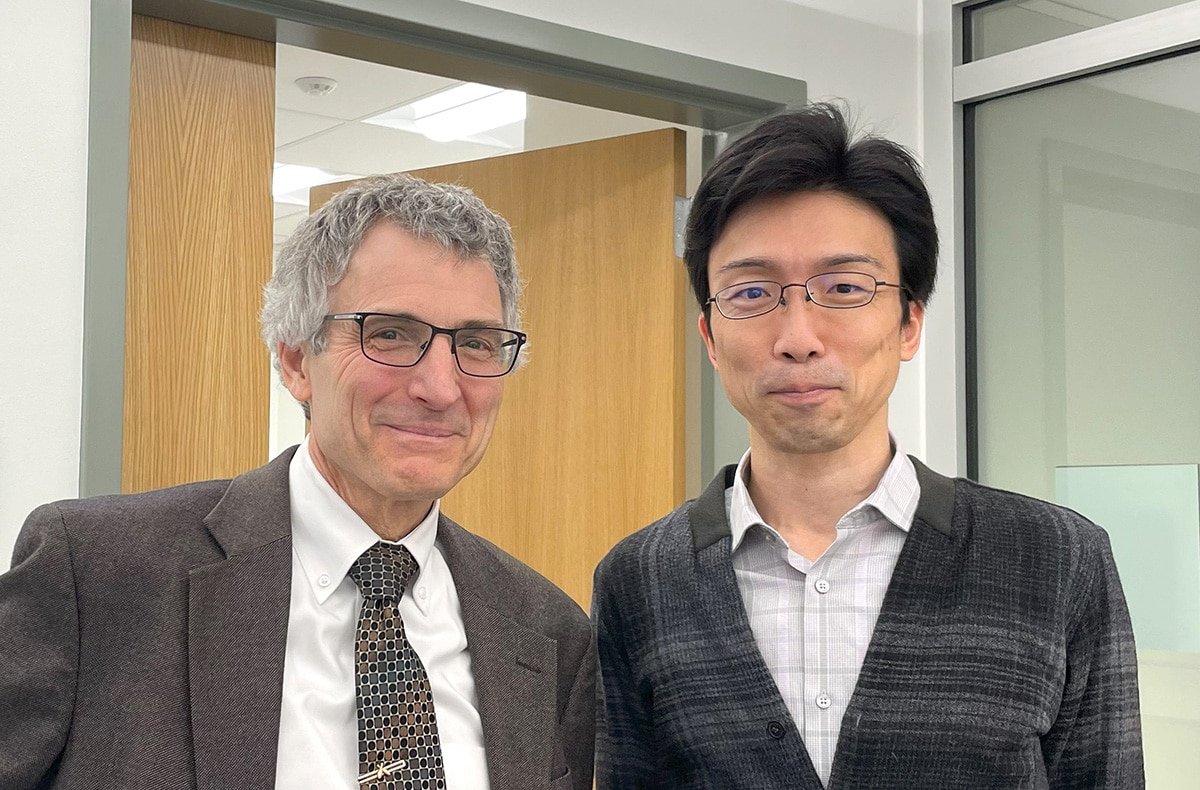
NIDDK explores new medications to treat obesity in adults and adolescents
By Heather Martin
Anti-obesity medications are an effective tool to help people with obesity lose weight, maintain their weight loss, and improve their health. Although several FDA-approved anti-obesity medications leading to modest weight loss have been available for adults for years, the recent approval of a new class of highly effective medications, such as glucagon-like peptide 1 (GLP-1) agonists, has put this option back into the spotlight.
The NIH Obesity Research Task Force Symposium: “Medications to Treat Obesity: Past, Present, and Future,” held in September 2023, explored the history of GLP-1s and other medications to treat obesity and how they work.
Even though the American Medical Association classified obesity as a disease more than a decade ago, there continues to be reluctance to use medication for what many people believe can be managed by diet and exercise alone. In addition, the most effective therapy for obesity, bariatric surgery, may not be an appropriate choice for most people, and comes with additional risks.
“Many people with obesity do well with behavioral treatment alone, but often, people with obesity can’t lose enough weight or maintain enough weight loss to improve health, so there’s a need for safe and effective therapies for obesity, including anti-obesity medications,” said Dr. Susan Yanovski, co-director of NIDDK’s Office of Obesity Research.
New anti-obesity medications change the landscape
The need for more safe and effective treatment for obesity is beginning to be met. In 2021 the FDA approved Wegovy (semaglutide) for chronic weight management in adults with obesity or overweight with at least one weight-related condition, such as high blood pressure, type 2 diabetes, or high cholesterol. The lower-dose of semaglutide, marketed under the brand name Ozempic, was first approved as a type 2 diabetes treatment in 2017.
Semaglutide and similar medications work by activating hormone receptors in the intestines, called glucagon-like peptide 1 (GLP-1) receptors, resulting in lower blood sugar, reduced hunger, and slower digestion, and act on receptors in the brain, which all help decrease appetite, reduce cravings, and signal fullness. While more research needs to be done to fully understand the mechanisms behind the effectiveness of these medication, clinical trial results have shown remarkable success for weight loss, with participants losing an average of 15% of their initial body weight. People who start taking anti-obesity medications should expect to stay on the medication long-term, since weight regain has been seen after discontinuation.
Researchers say that weight regain after stopping the medication does not mean the medication is ineffective, and they question why obesity is viewed differently than other chronic diseases. “We readily prescribe medications for other conditions that may respond to behavioral treatment, like high cholesterol,” said Yanovski. “And patients do not discontinue use of medications once their high cholesterol is managed and expect cholesterol to stay down, so we should not expect anti-obesity medications to continue to have an effect when stopped either.”
In 2023, the FDA approved another medication called Zepbound (tirzepatide), a dual-action drug that works similarly to semaglutide, activating the GLP-1 hormone receptors in the gut and another hormone receptor called glucose-dependent insulinotropic polypeptide (GIP). In clinical trials, people without diabetes lost an average of more than 20% of their initial bodyweight on Zepbound.
Many researchers believe we’ve entered a new era of obesity treatment, in which people can achieve weight loss of 15% or more without having to get surgery. Prior to the availability of these newer classes of medications, other obesity medications have been available but result in more modest weight loss (roughly 5-10% of initial body weight) and come along with safety concerns.
Anti-obesity medications for children and adolescents
The new anti-obesity medications do not just benefit adults. In 2022, the FDA approved Wegovy for adolescents ages 12 years and older meeting certain criteria, and in 2023 the American Academy of Pediatrics issued Clinical Practice Guidelines that includes medications as an adjunct treatment to intensive behavioral and lifestyle treatments in adolescents with obesity. In 2023, NIDDK convened leading scientific and clinical obesity experts and teens and parents with lived experience for a workshop focusing on children and adolescents to identify research gaps and opportunities in a rapidly changing obesity medicine landscape.
Dr. Sarah C. Armstrong, Chief of the Division of General Pediatrics and Adolescent Health at Duke University School of Medicine and co-chair of the workshop opened the first day by sharing the significance of shifting times, “No advances have portended the seismic shift in the approach to the potential effectiveness of obesity care for adolescents more than the new anti-obesity medications – clearly more powerful than the behavioral treatments we have, and more accessible than surgery. We are in a new, emerging paradigm of obesity care,” she said.
The two-day workshop included presentations on guidelines for pediatric obesity treatment and reviewed new research in the area, how obesity medications work, emerging therapies for children, clinical trial considerations and study designs, and impacts on mental health. Patients and their parents were also invited to share their perspectives.
“The NIH is listening very intently about what we all have to say about this, and we can be key players helping to set some of the priorities for funding for different areas to pursue in this realm,” said Dr. Aaron S. Kelly, co-chair of the workshop, professor of pediatrics and co-director of the Center for Pediatric Obesity Medicine at the University of Minnesota Medical School.
The path ahead for future research
Currently little research is available to guide many aspects of use of anti-obesity medications, such as which medication to use, when to start and stop, safe rates of weight loss, effects on lean body mass and bone, nutrient intakes, long-term effectiveness and adverse effects, mental health, cultural consideration in weight management, and telemedicine approaches.
There are also special considerations for children and adolescents. They are undergoing significant physical and psychological changes, and their treatment requires a family-centered approach. The long-lasting effects of obesity medications during developmental stages are unknown.
“Some of the most important advances in all of medicine will come from obesity medicine in the coming years,” said Kelly. “Obesity touches nearly all sub-specialties of medicine – if we get this right, we can get these kids on a healthy track for the rest of their lives.”
The workshop brought together many of the key players in pediatric obesity and identified several areas where NIH-supported research can fill in gaps and advance the field. “But like obesity, the solution is not simple. It is complex and nuanced, and it must occur at all levels,” said workshop co-chair Dr. Ihuoma Eneli, Professor of Pediatrics and Head of the Section of Nutrition at University of Colorado Anschutz Medical Campus and Children’s Hospital Colorado. “We are at an exciting time, and we have an opportunity to be innovative as we map out a solution.”
Inspiring and informing effective change in public administration

NIDDK Executive Officer Camille Hoover and Senior Management Analyst Robin Klevins contributed to two chapters in a new Government Analytics Handbook, in which they shared insights from NIDDK on how presenting survey data in a user-friendly manner is crucial to inspire action and positive change in public administration. The handbook, published by the World Bank, aims to help governments use analytics effectively to assess how they are doing, where they are functioning well, and where they can improve.
The NIDDK Executive Office created an innovative survey tool, EVS ART, which has been shared and used across the federal government.
Getting to Know: Dr. Teresa Jones
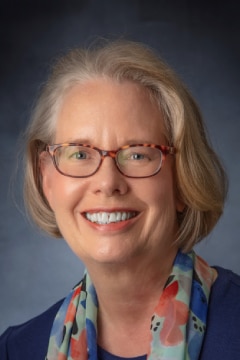
NIDDK has an active clinical research program examining diabetes complications, including the common yet challenging condition of diabetic foot ulcers. Dr. Teresa Jones, NIDDK’s program director overseeing funded research in this area, spoke to Alyssa Voss about this work and research opportunities on the horizon.
Can you tell me about your path to medicine and endocrinology? What brought you to NIDDK?
When I was in high school, I liked the thought of becoming a doctor because it combined science with helping people. I was fortunate to get into the honors medical program at Northwestern University in Illinois that combined college and medical school in a six-year program.
As an internal medicine resident, I was drawn to endocrinology because of the systemic aspects – that hormones act throughout the body and cause different conditions and affect metabolism. I also liked working with people to help them manage diabetes and insulin levels.
After my residency I came to NIDDK as a fellow in the endocrine training program. I worked in the lab of (former NIDDK Director) Dr. Allen Spiegel in G-protein signaling and protein lipidation. I later joined the Division of Diabetes, Endocrinology, and Metabolic Diseases as a program director, which allowed me to combine my research interests with my clinical experience.
You oversee a broad portfolio of research covering diabetes complications. Can you share some recent accomplishments and new projects coming soon?
Two recently posted funding opportunities are exciting possibilities for the field. One has to do with building a research consortium for the new NIH Cardiovascular Repository for Type 1 Diabetes (T1D), the first human biorepository for cardiovascular tissue from organ donors with and without diabetes. The project will bring together research teams to conduct various studies using donated tissue and post the data for other researchers to pursue other research questions. This unique resource allows the research community to examine the understudied area of diabetes and cardiovascular disease, which is a real step forward.
The other opportunity is to examine the potential for continuous ketone monitoring in people with T1D taking SGLT2 inhibitors. This drug class is effective in preventing kidney and cardiac disease, but it is not approved for use among people with T1D because of the high risk of ketoacidosis (a condition when high levels of ketones and acids in the blood can become dangerous if left untreated). Continuous ketone monitoring is one potential way to make it safer for people with T1D to take SGLT2 inhibitors, but this concept has not been studied before. It’s important to see if a new technology like this could work.
What is your proudest accomplishment?
The Diabetic Foot Consortium (DFC) is something I’m very proud of. Diabetic foot complications are a major public health problem with no good treatments. The idea was to build an infrastructure to identify and validate biomarkers and obtain human samples from people with diabetic foot ulcers to pursue studies that will result in better ways to predict wound healing and better treatments. So far the project has been a success – for one study we enrolled 418 people using a network of clinical sites and affiliates, which never would have been possible in a single site. The consortium has completed two clinical studies so far and will publish results soon. Next, the group will recruit a diverse cohort of people with diabetic foot ulcers and follow them for a full year to assess many more aspects of people as they experience diabetic foot ulcers. The study will collect biologic samples, measurements, images of diabetic wounds, and information on their social determinants of health including food insecurity and health literacy, which play an important role in patient outcomes. The DFC has also established patient advisory boards at each of the clinical sites involving people with diabetic foot ulcers and their families to get input on how this research can best serve them.

What advice do you have for students considering a career in research?
They should find mentors who can teach them how to ask the best research questions. It’s easy to get sidetracked by the next great technique or the day-to-day aspects of research, but focusing on the right research questions is essential to being a good scientist. I also encourage students and trainees to deeply understand the biology of the studies they pursue, even in clinical research. It’s important to understand the many levels of the science behind the project.
What kinds of things do you enjoy outside of work?
I love to garden vegetables and have fruit trees. I also enjoy any sort of water activity, especially boating with my family in Woods Hole (Massachusetts).

